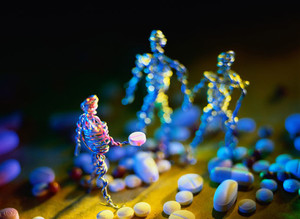Period: January to August 2012
After the patent on a biological medicine expires ‘similar’ versions of the originator biological can be produced. These biosimilars or ‘similar biological medicinal products’ are similar (but not identical) in terms of quality, safety and efficacy to an authorised reference biological medicine.
Unlike making small-molecule (chemical) drugs, manufacture of biologicals is complex. Biologicals generally exhibit high molecular complexity and may be quite sensitive to changes in manufacturing processes. Factors, such as light and temperature, can change the nature of the biological.
Manufacturers of biosimilars do not have access to the originator’s cell banks, nor to the exact fermentation and purification processes, nor to the active drug substance. They also, in most cases, do not have access to the commercialized originator product, making the process of development of a biosimilar challenging.
The question of how biosimilars manufacturers can compare their product to originator products and prove similarity and indeed encourage interchangeability is therefore a hot issue for biosimilars research.
This article discusses just some of the research articles on biosimilars that have been published during 2012, in the area of biosimilarity/comparability and interchangeabilty.
Biosimilarity/Comparability
Regulatory agencies generally require a comparability exercise following a manufacturing process change. This comparability is focused primarily on analytical characterization of the approved product before and after the manufacturing process change, with non-clinical and clinical confirmation required when determined necessary.
When developing a biosimilar, the manufacturer does not have access to key information including the originator’s cell line, cell culture conditions, purification procedures, and fill and finish processes. Further, the biosimilar manufacturer does not have access to information about the originator’s product development history, including knowledge about the quality attributes of lots used in non-clinical and clinical development. Lee et al. believe that a biosimilarity exercise to compare a biosimilar to an approved innovator biological requires a rigorous evaluation to ensure the safety and efficacy of the biosimilar and should go beyond a simple comparability exercise [1].
In further research Gravel et al. discuss key aspects of the development process and authorization requirements for biosimilars in Europe using published comparative physicochemical and clinical data for EU-approved recombinant human granulocyte colony-stimulating factor biosimilars. The authors demonstrate that the rigorous scientific evaluation process ensures the clinical safety and efficacy of biosimilars approved via the EMA abbreviated development programme [2].
Interchangeability
Interchangeability is the automatic switching of one drug for another without the need for referring back to the prescribing physician. In Europe, EMA does not have the authority to designate a biosimilar as interchangeable with the originator. This is a decision that is made at individual country level.
FDA does have this authority, however, how it will deem a biosimilar to be interchangeable has still not been defined. FDA did not cover the issue in its recently issued draft guidances, however, the agency has said that it would require switching studies to be carried out [3].
Chow* et al. propose a general approach for development of a biosimilarity index based on the concept of reproducibility probability for quantitative evaluation of biosimilarity and interchangeability. The proposed method is reported to be robust regardless of the biosimilarity criteria used and/or study design employed [4].
The research clearly highlights the areas where there is still more to be done in biosimilars. The issue of interchangeability has also been raised in a recent survey, making more important the need for educating the public, physicians and others, e.g. pharmacists, in the safety and efficacy of biosimilars [5].
*Professor Shein-Chung Chow is a member of the International Editorial Advisory Board of GaBI Journal, an expert in bioavailability/biosimilarity and bioequivalence; and is the guest editor of the Special Issue (educational editorial series) on 'Biosimilarity and Interchangeability' currently under production by GaBI Journal, contact us for more information on this Special Issue.
Related article
Overview of research on safety and immunogenicity of biosimilars in 2012
References
1. Lee JF, Litten JB, Grampp G. Comparability and biosimilarity: considerations for the healthcare provider. Curr Med Res Opin. 2012 Jun;28(6):1053-8.
2. Gravel P, Naik A, Le Cotonnec JY. Biosimilar rhG-CSFs: how similar are they? Target Oncol. 2012 Mar;7 Suppl 1:S3-16.
3. GaBI Online - Generics and Biosimilars Initiative. Biosimilars interchangeability, increased costs and burden for FDA [www.gabionline.net]. Mol, Belgium: Pro Pharma Communications International; [cited 2012 Oct 12]. Available from: www.gabionline.net/Biosimilars/General/Biosimilars-interchangeability-increased-costs-and-burden-for-FDA
4. Chow SC, Yang LY, Starr A, Chiu ST. Statistical methods for assessing interchangeability of biosimilars. Stat Med. 2012 Aug 17. doi: 10.1002/sim.5566. [Epub ahead of print]
5. GaBI Online - Generics and Biosimilars Initiative. Naming and interchangeability of biosimilars raised in new survey [www.gabionline.net]. Mol, Belgium: Pro Pharma Communications International; [cited 2012 Oct 12]. Available from: www.gabionline.net/Biosimilars/General/Naming-and-interchangeability-of-biosimilars-raised-in-new-survey
Permission granted to reproduce for personal and educational use only. All other reproduction, copy or reprinting of all or part of any ‘Content’ found on this website is strictly prohibited without the prior consent of the publisher. Contact the publisher to obtain permission before redistributing.








 0
0











Post your comment